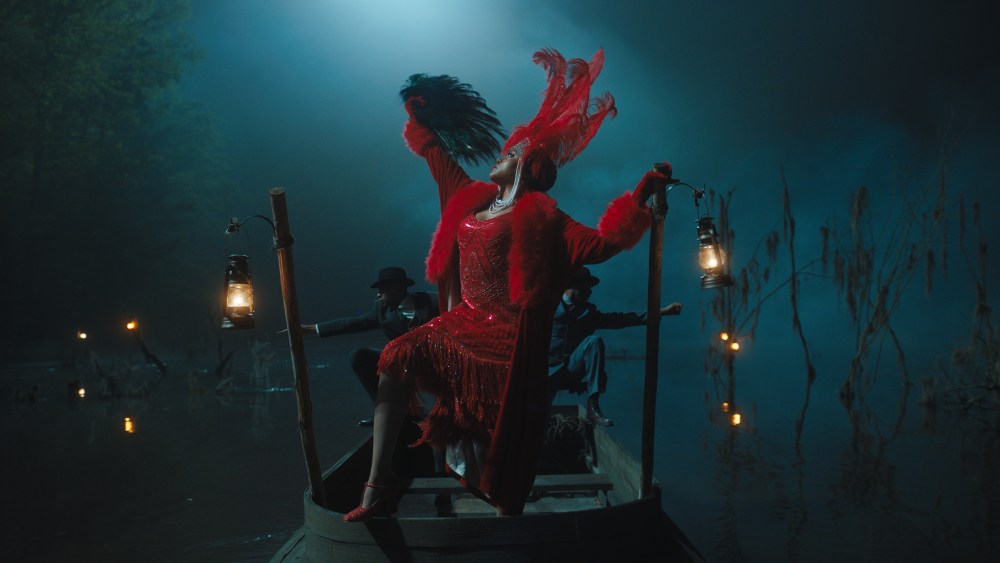‘The Color Purple’s’ ‘Push Da Button’ Was Inspired by Beyonce
Choreographer Fatima Robinson fused hip-hop, dance, African history, tap, jazz and even Jamaican moves as she crafted the musical numbers in “The Color Purple,” but there was one person in particular whose energy she wanted to capture: Beyoncé.
Specifically, the energy of Beyoncé’s “Renaissance.”
Director Blitz Bazawule blends Alice Walker’s text and the Broadway musical to reimagine the classic as a vibrant movie musical. “American Idol’s” Fantasia Barrino plays Celie, a woman who slowly finds her voice with Shug Avery’s (Taraji P. Henson) help. Shug isn’t just Mister’s (Colman Domingo) lover, she is a lounge singer from the big city. Preceding her arrival is a buzz of excitement in the “Shug Avery’s Comin to Town” number. But her big moment is the juke joint performance of “Push da Button,” and for that, Robinson wanted everything about it to “feel incredible.”
The juke joint was a place where people went to hang out and have a good time. Robinson likens it to history. She says, “The last flu pandemic was the Harlem Renaissance and people were locked up. When they came out of that, there was an explosion of dance.” That history is repeated in the present day with COVID and the lockdown. Says Robinson, “That’s why Beyoncé named her album ‘Renaissance,’ because we were in a pandemic. She created that album during the pandemic, and after the world exploded and wanted to do things. That was the energy I was trying to capture. Shug was the Beyoncé of her time.”
In the sequence, Shug saunters around the joint in a dazzling red beaded dress adorned with a feather headpiece, which was created by costume designer Francine Jamison Tanchuck. Robinson made sure there were plenty of props including handkerchiefs, scarves and even a cane. The idea was she always had something to play with. “I gave her movements, so she had somewhere to go and it wasn’t just a flat performance on stage,” says Robinson.
Throughout the film, Robinson’s choreography nods to African dance, hip-hop and jazz. But during “Push Da Button,” Bazawule’s camera focuses on one extra who is “daggering. “It’s a raunchy Jamaican dance, but I wanted to bring that rawness in,” she says.
As for the innuendo of the lyrics — the words allude to masturbation and draw from Walker’s words — it was important to not be obvious, at least for Robinson. “I’m into the elegance of things,” she says. “There is one shot where she touches her crotch while she’s on stage, and there are moments where she’s hitting her hips, or gyrating in the way people move certain parts of their body that says so much,” explains Robinson. But as Shug walks through the joint slapping one man at a time, Robinson says, “That’s her owning her power. It’s who she is. It was important to find strength for the women in that dance.”

“Hell No,” sung by Danielle Brooks is one of those moments where a woman finds her power.
It’s another showstopping moment, as Sophie (Brooks) commands the screen. Again, it was about simplicity for Robinson. “She’s so powerful, and I have two sisters who have my back. I know that sisterhood. The fact that her sisters were coming in to pack her up and take her away, nobody was getting in the way.” The movement also needed to have energy, but also elevate Celie. “All they do at the end is a flick, that’s all you need — it says ‘get out of my way.’”
Robinson wanted to veer away from packing in eight-count moves into a routine, because “Hell No” was not about that. Her process lay in telling the story first, then figuring out the moves, and having them make sense.
The choreographer spent time workshopping the number, as she did throughout the film. But after moving dancers around, changing angles, Robinson realized one thing, it came down to “the little head roll.”
Says Robinson, “I just love as Black people how we communicate. There are moves in there, that’s really just our language. In ‘Hell No’ when the girls are rolling their necks, that is a universal language of a woman being fed up and she’s had it up to here.”


